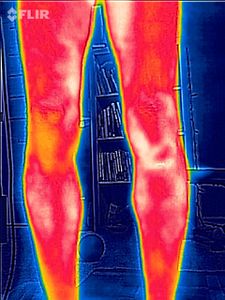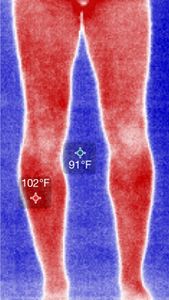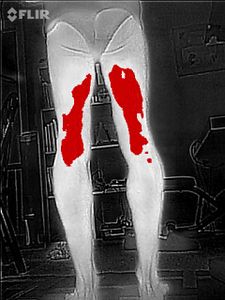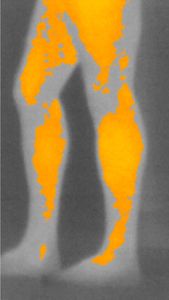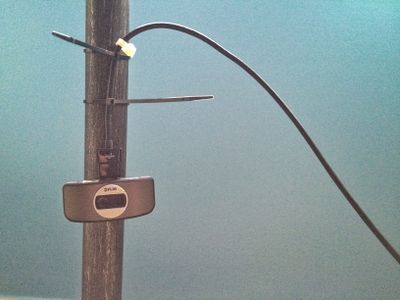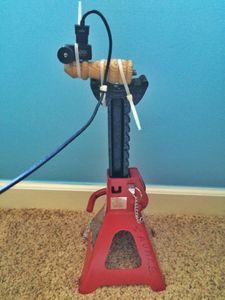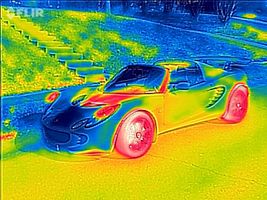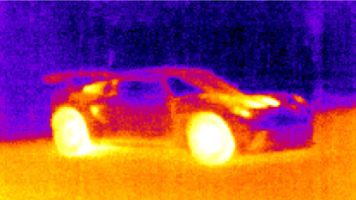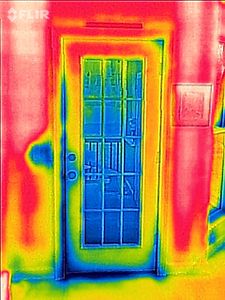Difference between revisions of "Thermal Camera"
User:Fellrnr (User talk:Fellrnr | contribs) m (comment: batch update) |
User:Fellrnr (User talk:Fellrnr | contribs) m (comment: batch update) |
||
| (One intermediate revision by the same user not shown) | |||
| Line 1: | Line 1: | ||
{{DISPLAYTITLE:Thermal Camera for Runners}} | {{DISPLAYTITLE:Thermal Camera for Runners}} | ||
| − | Thermal cameras can be useful in detecting muscular and joint issues, especially as they have recently become much cheaper. The camera shows where the skin is warmer, indicating inflammation or muscle damage. It can allow you to detect problems early, target your [[Massage]] more effectively, and monitor injury treatment. I find my thermal camera is also valuable for [[ | + | Thermal cameras can be useful in detecting muscular and joint issues, especially as they have recently become much cheaper. The camera shows where the skin is warmer, indicating inflammation or muscle damage. It can allow you to detect problems early, target your [[Massage]] more effectively, and monitor injury treatment. I find my thermal camera is also valuable for [[CoolSculpting]] and [[Cryotherapy| Cryotherapy (icing for recovery)]]. |
=Thermal Camera Research= | =Thermal Camera Research= | ||
Thermal cameras can reveal changes in skin temperature which reflect changes in blood flow due to inflammation and aid the diagnosis of several conditions<ref name="JiangNg2009"/>. For instance: | Thermal cameras can reveal changes in skin temperature which reflect changes in blood flow due to inflammation and aid the diagnosis of several conditions<ref name="JiangNg2009"/>. For instance: | ||
| Line 12: | Line 12: | ||
I use my thermal camera each morning after rising to evaluate muscular and joint health. It's important to let your skin adjust to the ambient temperature for 10-20 minutes. If you skin is in contact with fabric or furniture, that can skew the results. I use an extension cord so the camera is far enough away that I can view the images on my phone comfortably, and I take a photo each day for comparison. I'll use the images to track the progress of injuries, as the hotter areas indicate damage. I'll also use the images to target my [[Massage]], focusing on muscles that are hotter. After a run I'll use the camera to check for imbalances or changes in which muscle groups are activated (hotter). | I use my thermal camera each morning after rising to evaluate muscular and joint health. It's important to let your skin adjust to the ambient temperature for 10-20 minutes. If you skin is in contact with fabric or furniture, that can skew the results. I use an extension cord so the camera is far enough away that I can view the images on my phone comfortably, and I take a photo each day for comparison. I'll use the images to track the progress of injuries, as the hotter areas indicate damage. I'll also use the images to target my [[Massage]], focusing on muscles that are hotter. After a run I'll use the camera to check for imbalances or changes in which muscle groups are activated (hotter). | ||
=Which Camera?= | =Which Camera?= | ||
| − | I've used both the FLIR ONE | + | I've used both the FLIR ONE and the Seek Thermal XR <jfs id="B00SSZ5KPY" noreferb="true"/> and I prefer the FLIR, but both have their advantages. Currently, the FLIR ONE hasn't been discontinued, and they are working on releasing the third-generation replacement. (The Seek is available for Android as <jfs id=" B00NYWAHHM" noreferb="true"/>.) |
* The FLIR uses their patented MSX which uses a visual camera to create an outline image that's then merged with the thermal image. I found that this made the FLIR rather more useful and easier to interpret than the Seek and was a major factor for me. The MSX approach doesn't work so well for close up images, but I've not found that to be too much of an issue. | * The FLIR uses their patented MSX which uses a visual camera to create an outline image that's then merged with the thermal image. I found that this made the FLIR rather more useful and easier to interpret than the Seek and was a major factor for me. The MSX approach doesn't work so well for close up images, but I've not found that to be too much of an issue. | ||
* The FLIR has a wider angle of view than the Seek, which makes it easier to use. The Seek is only 20 degrees, which for photographers is about a 120mm lens on a 35mm camera. For non-photographers, it's annoyingly narrow. (There is a non-XR Seek camera with a 36 degree view as <jfs id="B00NYWABAA" noreferb="true"/>.) | * The FLIR has a wider angle of view than the Seek, which makes it easier to use. The Seek is only 20 degrees, which for photographers is about a 120mm lens on a 35mm camera. For non-photographers, it's annoyingly narrow. (There is a non-XR Seek camera with a 36 degree view as <jfs id="B00NYWABAA" noreferb="true"/>.) | ||
* I found the FLIR gave me more useful images. This is extremely subjective, but I found that I could interpret the FLIR images more easily and understand the issues more clearly than I could we the Seek. I didn't have the two cameras concurrently, so I couldn't do back to back comparisons. | * I found the FLIR gave me more useful images. This is extremely subjective, but I found that I could interpret the FLIR images more easily and understand the issues more clearly than I could we the Seek. I didn't have the two cameras concurrently, so I couldn't do back to back comparisons. | ||
* The thermal range of both cameras is fine for most purposes, but the Seek covers from -40f up to 626f where the FLIR only covers -4°F to 248°F. | * The thermal range of both cameras is fine for most purposes, but the Seek covers from -40f up to 626f where the FLIR only covers -4°F to 248°F. | ||
| − | * Both cameras have a stunningly low resolution thermal sensor; the FLIR is 160 × 120 and the Seek is 206 x 156. This is one of the reasons why the FLIR MSX helps make sense out of the blurry thermal images. | + | * Both cameras have a stunningly low resolution thermal sensor; the FLIR is 160 × 120 and the Seek is 206 x 156. This is one of the reasons why the FLIR MSX helps make sense out of the blurry thermal images. (The third-generation FLIR ONE is only 80x60, and the FLIR ONE PRO is 160x120, so the "PRO" is the replacement for the second generation FLIR ONE, and the third-generation FLIR ONE is actually a lower end camera.) |
* Both seem to have similar absolute accuracy based on comparison with a spot thermometer (<jfs id="B00MNDAKW0" noreferb="true"/>). In theory you might be able to use a spot thermometer to perform a similar analysis, but in practice it's too hard to understand the variation. | * Both seem to have similar absolute accuracy based on comparison with a spot thermometer (<jfs id="B00MNDAKW0" noreferb="true"/>). In theory you might be able to use a spot thermometer to perform a similar analysis, but in practice it's too hard to understand the variation. | ||
* The Seek uses the camera's battery where the FLIR has its own battery. The Seek solution is better as the impact on your phone's battery life is not huge and you don't have another device to charge up. You also have to plug the FLIR in and turn it on, where the Seek just plugs in. | * The Seek uses the camera's battery where the FLIR has its own battery. The Seek solution is better as the impact on your phone's battery life is not huge and you don't have another device to charge up. You also have to plug the FLIR in and turn it on, where the Seek just plugs in. | ||
Latest revision as of 12:45, 25 May 2017
Thermal cameras can be useful in detecting muscular and joint issues, especially as they have recently become much cheaper. The camera shows where the skin is warmer, indicating inflammation or muscle damage. It can allow you to detect problems early, target your Massage more effectively, and monitor injury treatment. I find my thermal camera is also valuable for CoolSculpting and Cryotherapy (icing for recovery).
Contents
1 Thermal Camera Research
Thermal cameras can reveal changes in skin temperature which reflect changes in blood flow due to inflammation and aid the diagnosis of several conditions[1]. For instance:
- A Thermal Camera can reveal the higher skin temperatures that occur with Delayed Onset Muscle Soreness, with skin temperatures over the damaged muscles showing about 1c higher[2][3]. I believe that thermal cameras can also reveal other types of muscle damage, which can be used to optimize Massage.
- Thermal imaging can reveal the pattern of rheumatoid arthritis, and the effectiveness of treatments[4]. It seems reasonable to me that this approach can also reveal other types of join damage, especially when the two sides of the body can be compared.
- Thermal imaging can also be used to determine the pattern of active muscles[3]. I believe this can be used to detect muscular imbalances by comparing the two sides of the body just after a run.
- Analysis of low back pain intensity might be usefully supplemented with thermal imaging[5].
- Thermal imaging can be used for more serious conditions[6][7], but that's outside the scope of this article.
Many factors can influence the absolute skin temperature, including ambient temperature, time of day, BMI, etc.[8], so I'd recommend looking at the temperature pattern across the body. In addition, it's best to use LED lighting as it emits little infrared light, and avoid anything warm in the frame[2].
2 How to use a Thermal Camera
I use my thermal camera each morning after rising to evaluate muscular and joint health. It's important to let your skin adjust to the ambient temperature for 10-20 minutes. If you skin is in contact with fabric or furniture, that can skew the results. I use an extension cord so the camera is far enough away that I can view the images on my phone comfortably, and I take a photo each day for comparison. I'll use the images to track the progress of injuries, as the hotter areas indicate damage. I'll also use the images to target my Massage, focusing on muscles that are hotter. After a run I'll use the camera to check for imbalances or changes in which muscle groups are activated (hotter).
3 Which Camera?
I've used both the FLIR ONE and the Seek Thermal XR Error: Could not parse data from Amazon! and I prefer the FLIR, but both have their advantages. Currently, the FLIR ONE hasn't been discontinued, and they are working on releasing the third-generation replacement. (The Seek is available for Android as Error: Could not parse data from Amazon!.)
- The FLIR uses their patented MSX which uses a visual camera to create an outline image that's then merged with the thermal image. I found that this made the FLIR rather more useful and easier to interpret than the Seek and was a major factor for me. The MSX approach doesn't work so well for close up images, but I've not found that to be too much of an issue.
- The FLIR has a wider angle of view than the Seek, which makes it easier to use. The Seek is only 20 degrees, which for photographers is about a 120mm lens on a 35mm camera. For non-photographers, it's annoyingly narrow. (There is a non-XR Seek camera with a 36 degree view as Error: Could not parse data from Amazon!.)
- I found the FLIR gave me more useful images. This is extremely subjective, but I found that I could interpret the FLIR images more easily and understand the issues more clearly than I could we the Seek. I didn't have the two cameras concurrently, so I couldn't do back to back comparisons.
- The thermal range of both cameras is fine for most purposes, but the Seek covers from -40f up to 626f where the FLIR only covers -4°F to 248°F.
- Both cameras have a stunningly low resolution thermal sensor; the FLIR is 160 × 120 and the Seek is 206 x 156. This is one of the reasons why the FLIR MSX helps make sense out of the blurry thermal images. (The third-generation FLIR ONE is only 80x60, and the FLIR ONE PRO is 160x120, so the "PRO" is the replacement for the second generation FLIR ONE, and the third-generation FLIR ONE is actually a lower end camera.)
- Both seem to have similar absolute accuracy based on comparison with a spot thermometer (Error: Could not parse data from Amazon!). In theory you might be able to use a spot thermometer to perform a similar analysis, but in practice it's too hard to understand the variation.
- The Seek uses the camera's battery where the FLIR has its own battery. The Seek solution is better as the impact on your phone's battery life is not huge and you don't have another device to charge up. You also have to plug the FLIR in and turn it on, where the Seek just plugs in.
- The Seek iOS app has a few more modes than the FLIR, such as showing the hottest and coldest spot temperatures, or graying out temperatures above or below certain ranges. Both offer a range of mappings between temperature and color.
- The Seek is smaller than the FLIR, but not by enough to make much difference in practice.
- Both worked fine with a lightning extension cable (Error: Could not parse data from Amazon!).
4 Gallary
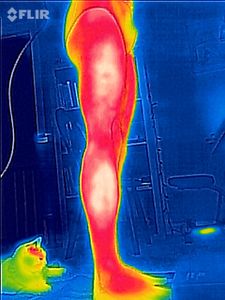 Here's a side image of my legs, showing the hot spots in my quads and tibialis anterior which shouldn't be that hot! Also, don't have a cat in the picture like I did here as warm objects can skew the temperature readings. |
5 References
- ↑ L. J. Jiang, E. Y. K. Ng, A. C. B. Yeo, S. Wu, F. Pan, W. Y. Yau, J. H. Chen, Y. Yang, A perspective on medical infrared imaging, Journal of Medical Engineering & Technology, volume 29, issue 6, 2009, pages 257–267, ISSN 0309-1902, doi 10.1080/03091900512331333158
- ↑ 2.0 2.1 HH. Al-Nakhli, JS. Petrofsky, MS. Laymon, LS. Berk, The use of thermal infra-red imaging to detect delayed onset muscle soreness., J Vis Exp, issue 59, 2012, doi 10.3791/3551, PMID 22297829
- ↑ 3.0 3.1 E.B. Neves, J.V. Alves, E. Krueger, V.M. Reis, Changes in Skin Temperature During Muscular Work: A Pilot Study, Pan American Journal of Medical Thermology, volume 1, issue 1, 2014, pages 11–15, ISSN 23584696, doi 10.18073/2358-4696/pajmt.v1n1p11-15
- ↑ EF. Ring, AJ. Collins, PA. Bacon, JA. Cosh, Quantitation of thermography in arthritis using multi-isothermal analysis. II. Effect of nonsteroidal anti-inflammatory therapy on the thermographic index., Ann Rheum Dis, volume 33, issue 4, pages 353-6, Jul 1974, PMID 4415420
- ↑ N. Zaproudina, Z. Ming, OO. Hänninen, Plantar infrared thermography measurements and low back pain intensity., J Manipulative Physiol Ther, volume 29, issue 3, pages 219-23, doi 10.1016/j.jmpt.2006.01.003, PMID 16584947
- ↑ C. Herman, MP. Cetingul, Quantitative visualization and detection of skin cancer using dynamic thermal imaging., J Vis Exp, issue 51, 2011, doi 10.3791/2679, PMID 21587160
- ↑ Nimmi Arora, Diana Martins, Danielle Ruggerio, Eleni Tousimis, Alexander J. Swistel, Michael P. Osborne, Rache M. Simmons, Effectiveness of a noninvasive digital infrared thermal imaging system in the detection of breast cancer, The American Journal of Surgery, volume 196, issue 4, 2008, pages 523–526, ISSN 00029610, doi 10.1016/j.amjsurg.2008.06.015
- ↑ Ismael Fernández-Cuevas, Joao Carlos Bouzas Marins, Javier Arnáiz Lastras, Pedro María Gómez Carmona, Sergio Piñonosa Cano, Miguel Ángel García-Concepción, Manuel Sillero-Quintana, Classification of factors influencing the use of infrared thermography in humans: A review, Infrared Physics & Technology, volume 71, 2015, pages 28–55, ISSN 13504495, doi 10.1016/j.infrared.2015.02.007
